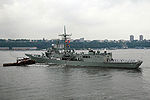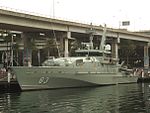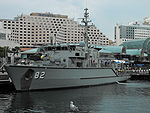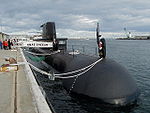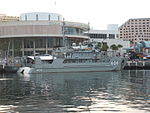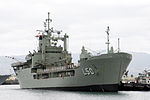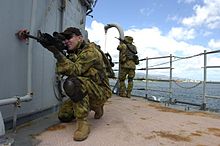- Royal Australian Navy
-
Royal Australian Navy 
Badge of the Royal Australian NavyActive 1911–Present Country  Australia
AustraliaType Navy Size 14,215 permanent personnel
2,150 Active Reserve personnel
54 vesselsPart of Australian Defence Force Headquarters Russell Offices, Canberra March "Royal Australian Navy" Anniversaries 10 July Engagements First World War
Second World War
Korean War
Malayan Emergency
Indonesian Confrontation
Vietnam War
Gulf War
War in Afghanistan
Iraq WarWebsite www.navy.gov.au Commanders Chief of the Defence Force General David Hurley AC, DSC Chief of Navy Vice Admiral Ray Griggs AM, CSC Deputy Chief of Navy Rear Admiral Trevor Jones AM, CSC Commander Australian Fleet Rear Admiral Steve Gilmore AM, CSC Notable
commandersVADM Sir William Creswell
VADM Sir John Collins
ADML Sir Victor Smith
VADM Sir Richard Peek
ADML Chris Barrie
VADM Russ CraneInsignia Naval Ensign of Australia
(1967-present)
Naval Ensign of Australia (1911-1967) 
The Royal Australian Navy (RAN) is the naval branch of the Australian Defence Force. Following the Federation of Australia in 1901, the ships and resources of the separate colonial navies were integrated into a national force: the Commonwealth Naval Forces. Originally intended for local defence, the navy was granted the title of 'Royal Australian Navy' in 1911, and became increasingly responsible for defence of the region.
Britain's Royal Navy continued to support the RAN and provide additional blue-water defence capability in the Pacific up to the early years of World War II. Then, rapid wartime expansion saw the acquisition of large surface vessels and the building of many smaller warships. In the decade following the war, the RAN acquired a small number of aircraft carriers, the last of these paying off in 1982.
Today, the RAN consists of 54 vessels and over 16,000 personnel. The navy is one of the largest and most sophisticated naval forces in the Pacific region, with a significant presence in the Indian Ocean and worldwide operations in support of military campaigns and peacekeeping missions. The current Chief of Navy is Vice Admiral Ray Griggs.[1]
Contents
History
The Commonwealth Naval Forces were established on 1 March 1901, two months after the federation of Australia. On 10 July 1911, King George V granted the title of 'Royal Australian Navy'.[2]
During World War I, the RAN was initially responsible for capturing many of Germany's South Pacific colonies and protecting Australian shipping from the German East Asia Squadron. Later in the war, most of the RAN's major ships operated as part of Royal Navy forces in the Mediterranean and North Seas.
During the 1920s and early 1930s, the RAN was drastically reduced in size. As international tensions increased, however, the RAN was modernised and expanded. Early in World War II, RAN ships again operated as part of the Royal Navy, many serving with distinction in the Mediterranean, the Red Sea, the West African coast, the Persian Gulf, and the Indian Ocean. Following the outbreak of the Pacific War and the virtual destruction of the Royal Navy force in Asia, the RAN operated more independently, or as part of United States Navy forces. By war's end, the RAN was the fifth-largest navy in the world.
After World War II, the size of the RAN was again reduced, but it gained new capabilities with the delivery of two aircraft carriers. The RAN saw action in many Cold War-era conflicts in the Asia-Pacific region and operated alongside the Royal Navy and United States Navy off Korea, Malaysia and Vietnam. Since the end of the Cold War, the RAN has been part of Coalition forces in the Persian Gulf and Indian Ocean and has become a critical element in Australian operations in East Timor and the Solomon Islands.
RAN today
Command structure
The strategic command structure of the RAN was overhauled during the New Generation Navy changes.
The RAN is commanded through Naval Headquarters (NHQ) in Canberra. The professional head is the Chief of Navy (CN), who holds the rank of Vice-Admiral. NHQ is responsible for implementing policy decisions handed down from the Department of Defence and for overseeing tactical and operational issues that are the purview of the subordinate commands.
Beneath NHQ are two subordinate commands:
- Fleet Command – fleet command is led by Commander Australian Fleet (COMAUSFLT). COMAUSFLT holds the rank of Rear Admiral; previously, this post was Flag Officer Commanding HM's Australian Fleet (FOCAF), created in 1911,[3] but the title was changed in 1988 to the Maritime Commander Australia. On 1 February 2007, the title changed again, becoming Commander Australian Fleet.[4] The nominated at-sea commander is Commodore Flotillas (COMFLOT), a one-star deployable task group commander. Fleet command has responsibility to CN for the full command of assigned assets, and to Joint Operations command for the provision of operationally ready forces.
- Navy Strategic Command – the administrative element overseeing the RAN's training, engineering and logistical support needs. Instituted in 2000, the Systems Commander was appointed at the rank of Commodore; in June 2008, the position was upgraded to the rank of Rear Admiral.
Fleet Command was previously made up of seven Force Element Groups, but after the New Generation Navy changes, this was restructured into four Force Commands:[5]:
- Surface Force, covering the RAN's surface combatants (generally ships of frigate size or larger)
- Submarine Force, operating the Collins class submarines
- Mine Warfare, Hydrographic and Patrol Boat Force, an amalgamation of the previous Patrol Boat, Hydrographic, and Mine Warfare and Clearance Diving Forces, operating what are collectively termed the RAN's "minor war vessels"
- Fleet Air Arm, responsible for the navy's aviation assets
Fleet
As of 2011, the RAN fleet consisted of 54 vessels, including frigates, submarines, patrol boats and auxiliary ships. Ships commissioned into the RAN are given the prefix HMAS (His/Her Majesty's Australian Ship).
The RAN has two primary bases for its fleet:
- Fleet Base East, located at HMAS Kuttabul, Sydney; and
- Fleet Base West, located at HMAS Stirling, near Perth.
In addition, three other bases are home to the majority of the RAN's minor war vessels:
- HMAS Coonawarra, at Darwin;
- HMAS Cairns, at Cairns; and
- HMAS Waterhen, at Sydney.
Current ships
See also: Current Royal Australian Navy shipsThe RAN currently operates 54 commissioned vessels, made up of nine ship classes, and three individual ships.
Image Class/Name Type Number Entered service Details Anzac class Frigate 8 1996 Anti-submarine and anti-aircraft frigate with 1 S-70B-2 Seahawk helicopter. Two more were built for the Royal New Zealand Navy. Adelaide class Frigate 4 1985 Anti-submarine and anti-aircraft frigate with 2 Sikorsky S-70B-2 Seahawk helicopters. Two more ships were decommissioned in 2005 and 2008. Armidale class Patrol boat 14 2005 Coastal defence, maritime border, and fishery protection Huon class Minehunter 6 1997 Minehunting Collins class Submarine 6 2000 Anti-shipping, intelligence collection. Diesel-electric powered. Balikpapan class Landing Craft Heavy 6 1971 Light lift amphibious transport. Two more were transferred to the fledgling Papua New Guinea Defence Force in 1975. Leeuwin class Survey ship 2 2000 Hydrographic survey Paluma class Survey launch 4 1989 Hydrographic survey HMAS Tobruk Landing Ship Heavy – 1989 Heavy sealift and transport. Modified Round Table class. HMAS Kanimbla Amphibious transport – 1994 Troop and helicopter transport. Kanimbla class (modified from the United States Navy's Newport class. A second vessel of the class was decommissioned in 2011. HMAS Success Replenishment ship – 1986 Replenishment at sea and afloat support. Modified Durance class. HMAS Sirius Replenishment ship – 2006 Replenishment at sea and afloat support. Modified commercial tanker. Fleet Air Arm
The Australian Navy Aviation Group (known informally as the Fleet Air Arm) provides the RAN's aviation capability. As of 2011, the FAA consists of three active squadrons, operating four helicopter types in the anti-submarine warfare and maritime support roles.[6] The Fleet Air Arm is based at HMAS Albatross in Nowra, New South Wales, and operates from the RAN's frigates, large amphibious warfare vessels, and large support ships.
Clearance Diving Teams
The RAN has two Clearance Diving Teams that serve as parent units for naval clearance divers:
- Clearance Diving Team 1 (AUSCDT ONE), based at HMAS Waterhen in New South Wales; and
- Clearance Diving Team 4 (AUSCDT FOUR), based at HMAS Stirling in Western Australia.
When RAN personnel are sent into combat, Clearance Diving Team Three (AUSCDT THREE) is formed.
The CDTs have two primary roles:
- Mine counter-measures (MCM) and explosive ordnance disposal (EOD); and
- Maritime tactical operations.
Future
There are currently several major projects underway that will see upgrades to RAN capabilities:
- Project AIR 9000 Phase 8 is a project to replace the RAN's Seahawk (and Seasprite) helicopters with twenty-four Naval Combat Helicopters (NH90 NFH or MH-60R).
- Project JP 2048 Phases 4A and 4B is a project to build two Canberra-class Landing Helicopter Dock (LHD) amphibious ships (based on the Spanish Buque de Proyección Estratégica). These will be the largest RAN warships ever commissioned and will replace HMAS Tobruk and a Kanimbla class vessel. The project is on schedule for the vessels to be accepted in January 2014 (HMAS Canberra) and August 2015 (HMAS Adelaide).[7]
- Project JP 2048 Phase 3 will provide six Heavy Landing Craft to replace the RAN's Balikpapan-class vessels. The project is planned to deliver capability in 2014–2016.
- Project SEA 1390 Phase 2.1 will see the upgrading of four Adelaide-class guided missile frigates with enhanced weapons and electronics.
- Project SEA 1429 will upgrade the Collins-class submarines with state-of-the-art heavyweight torpedoes.
- Project SEA 1439 Phase 4A will equip the Collins-class submarines with a new tactical combat system.
- Project SEA 1654 Phase 3 is a project to acquire a Sea Logistic Support and Replenishment Support vessel to replace the supply ship HMAS Success.
- Project SEA 4000, under which the RAN will acquire three Hobart-class Air Warfare Destroyers, built around the United States Navy Aegis air and surface combat management system. The vessels are be based on the Spanish Álvaro de Bazán-class frigate.[8][9] The project is on schedule to deliver the first ship, HMAS Hobart, in December 2014. HMAS Brisbane and HMAS Sydney are due to be delivered in March 2016 and June 2017 respectively.[10]
To boost the RAN's amphibious capability until the arrival of the Canberra class LHDs, the RAN purchased Largs Bay from the British Royal Fleet Auxiliary in April 2011 for £65 million. It is expected to be delivered in late-2011 and later commissioned as HMAS Choules.[11][12]
The RAN needs 2,000 recruits, including 700 apprentices,[13] to crew the next generation of warships, such as air warfare destroyers, which enter service next decade.
Future procurement plans include:
- twelve Future Submarines, under Project SEA 1000, to replace the Collins-class (up to 4,000 tons, equipped with cruise missiles and minisubs);
- eight Future Frigates to replace the Anzac-class frigates (possibly up to 7,000 tons and equipped with cruise missiles);
- twenty Offshore Combatant Vessels, under Project SEA 1180, to replace the Armidale, Huon, Leeuwin, and Paluma classes (up to 2000 tons); and
- one Strategic Sealift Vessel to replace the second Kanimbla-class ship (~15,000 tons, similar to the Spanish Galicia-class landing platform dock).[14]
In order to pay for this new equipment, the service is making cuts in other areas, such as meals for the sailors.[15]
Current operations
The RAN currently has forces deployed on three major operations:[16]
- Operation Anode – Australia's contribution to the Regional Assistance Mission in the Solomon Islands.
- Operation Slipper – Australia's commitment to the International Coalition forces in Afghanistan and against Terrorism (ICAT). The RAN's contribution is normally one ship in the Persian Gulf.
- Operation Resolute – the ADF's contribution to patrolling Australia's Exclusive Economic Zone. The RAN's contribution to Resolute is at least seven Armidale class patrol boats, plus a large surface combatant on standby.[17]
In late 2010, as part of cost-saving measures, the RAN has ordered ships to reduce operating speeds and cut time at sea.[18]
Personnel
As of June 2011, the RAN has 14,215 permanent full time personnel, 161 gap year personnel, and 2,150 reserve personnel.[19] The permanent full time force consisted of 3,357 commissioned officers, and 10,697 enlisted personnel.[19] As of June 2010 male personnel make up 82% of the permanent full time force, while female personnel make up 18%.[20] The RAN has the highest percentage of women in the ADF, compared to the RAAF's 17.8% and the Army's 9.7%.[20]
The following is the current senior Royal Australian Navy Officers;
- Vice Admiral Ray Griggs, AM, CSC, RAN - Chief of Navy
- Rear Admiral Trevor Jones, AM, CSC, RAN - Deputy Chief of Navy
- Rear Admiral Steve Gilmore, AM, CSC, RAN - Commander Australian Fleet
- Rear Admiral Michael Uzzell, AM, RAN - Head Navy Engineering
- Warrant Officer of the Navy Mark Tandy, CSC - Warrant Officer of the Navy
Ranks and uniforms
The uniforms of the Royal Australian Navy are very similar in cut, colour and insignia to their British Royal Navy forerunners. However, beginning with the Second World War all RAN personnel began wearing shoulder flashes reading Australia, a practice continuing today. These are cloth arcs at shoulder height on uniforms, metallic gold on officers' shoulder boards, and embroidered on shoulder slip-ons.
Commissioned officers
Commissioned officers of the Australian Navy have pay grades ranging from S-1 to O-11. The only O-11 position in the navy is honorary and has only ever been held by royalty, currently being held by HRH The Duke of Edinburgh. The highest position occupied in the current Royal Australian Navy structure is O-9, a Vice-Admiral who serves as the Chief of the Navy. O-7 (Commodore) to O-11 (Admiral of the Fleet) are referred to as flag officers, O-4 (Lieutenant-Commander) to O-6 (Captain(N)) are referred to as senior officers, while S-1 (Midshipman) to O-3 (Lieutenant) are referred to as junior officers. Naval Cadets are referred to as subordinate officers. All officers of the Navy receive a commission from Her Majesty Queen Elizabeth the Second, Queen of Australia. The Commissioning Scroll issued in recognition of the commission is signed by the Governor General of Australia as Commander-in-Chief and the serving Minister for Defence.
Naval officers are trained at the Royal Australian Naval College (HMAS Creswell) in Jervis Bay, New South Wales and the Australian Defence Force Academy in Canberra.
Commissioned Officer Rank Structure of the Royal Australian Navy Admiral of the Fleet Admiral Vice Admiral Rear Admiral Commodore Captain O-11 O-10 O-9 O-8 O-7 O-6 










AF ADML VADM RADM CDRE CAPT Commander Lieutenant-Commander Lieutenant Sub-Lieutenant Acting Sub-Lieutenant Midshipman Officer Cadet O-5 O-4 O-3 O-2 O-1 S-1 Cadet 






CMDR LCDR LEUT SBLT ASLT MIDN OC Non-commissioned ranks
CODE Warrant Officers E-9 Warrant Officer of the Navy E-9 Warrant Officer Senior Non-commissioned Officers E-8 Chief Petty Officer E-7 – E-6 Petty Officer Junior Non-commissioned Officers E-5 Leading Seaman E-4 – Enlisted E-3 Able Seaman E-2 Seaman Chaplains
Further information: Military chaplain#Australia and Catholic Diocese of the Australian Defence ForceRoyal Australian Navy (RAN) chaplains are commissioned officers and wear the uniform of a RAN officer. Like chaplains in the Royal Navy (RN), they do not wear rank insignia, but instead wear epaulettes with a cross-and-anchor insignia. Like other chaplains in the Australian Defence Force (ADF), Navy chaplains have five divisions of seniority. Australian Navy chaplains are accorded a certain rank for protocol and ceremonial occasions and for saluting purposes. Division 1, 2 and 3 Australian Navy chaplains are accorded the rank and status as Commander (equivalent of Lieutenant Colonel in the Australian Army). Division 4 Australian Navy chaplains are accorded the rank and status of Captain (equivalent of Colonel). Division 5 Australian Navy chaplains are "Principal Chaplains," and these three chaplains, representing the three major Christian denominations: Catholic, Anglican and Protestant, are accorded the rank and status of Commodore (equivalent of Brigadier). Principal Chaplains' uniforms do not differ from other Navy chaplains however they do wear gold braid on the peak of their caps. The title "Padre" for chaplains is less common in the Royal Australian Navy, than in the Australian Army, although it is known to be used by many sailors and some Navy chaplains in preference to the more formal title of "Chaplain", or other formal forms of address towards an officer such as "Sir."[citation needed]
See also
- Australian White Ensign
- Royal Australian Navy School of Underwater Medicine
References
- ^ "Navy welcomes new Chief" (Press release). Department of Defence. 7 June 2011. http://www.defence.gov.au/media/DepartmentalTpl.cfm?CurrentId=11937. Retrieved 9 June 2011.
- ^ "The R.A.N. – A Brief History". Royal Australian Navy. http://www.navy.gov.au/The_R.A.N._-_A_Brief_History. Retrieved 19 September 2008.
- ^ C L Cumberlege
- ^ Top Stories
- ^ Australian Maritime Doctrine, p. 124
- ^ "Aviation Group". Royal Australian Navy. http://www.navy.gov.au/Aviation_Group. Retrieved 6 January 2011.
- ^ Amphibious Deployment and Sustainment – JP 2048 Phase 4A/B
- ^ Commonwealth of Australia (2009). Defence White Paper 2009. Commonwealth of Australia. pp. 70–74. ISBN 9780642297020. http://www.defence.gov.au/whitepaper/docs/defence_white_paper_2009.pdf. Retrieved 1 September 2010.
- ^ "Defence Materiel Organisation". DMO Projects. Commonwealth of Australia. http://www.defence.gov.au/dmo/lsp/index.cfm. Retrieved 1 September 2010.[dead link]
- ^ AWD Destroyers SEA 04000 Phase 3 Build
- ^ Capability boost as Navy acquires new ship.
- ^ Naming of ex-RFA Largs Bay as HMAS Choules
- ^ Defence White Paper 2009. pp. 114.
- ^ Defence White Paper 2009. pp. 70–74.
- ^ Maiden, Samantha (23 October 2011). "Our sailors will miss out on dessert to fund new equipment". Sunday Herald Sun. http://www.heraldsun.com.au/news/more-news/dessert-off-navy-menu-to-cut-costs/story-fn7x8me2-1226173963478. Retrieved 23 October 2011.
- ^ http://www.navy.gov.au/operations/
- ^ Border Protection of Australia
- ^ McPhedran, Ian (1 November 2010). "Warships ordered to go slower". The Daily Telegraph. http://www.dailytelegraph.com.au/news/warships-ordered-to-go-slower/story-e6freuy9-1225945817189. Retrieved 1 November 2010.
- ^ a b Department of Defence (2011). Portfolio Budget Statements 2011–12: Defence Portfolio. Canberra: Commonwealth of Australia. p. 39. ISBN 978-0-642-29739-6. http://www.defence.gov.au/budget/11-12/pbs/2011-2012_Defence_PBS_Complete.pdf.
- ^ a b Defence Annual Report 2009-2010, Appendix 7, Table A7.3
External links
- Royal Australian Navy home page
- 'Virtual Fleet' – on-line computer based 'tour' of ships and aircraft
- Maritimequest Royal Australian Navy photo gallery
- Official Biographies:
- Royal and Dominion Navies in World War II, Campaigns, Battles, Warship losses
Royal Australian Navy Components History Ships and aircraft Other  Australian Defence Force
Australian Defence ForceRoyal Australian Navy
Overview Department of Defence · Australian Defence Organisation · Current deployments · Military bases · Women in the Australian military · ConscriptionHistory Frontier wars · World War I · World War II · Korean War · Indonesia-Malaysia Confrontation · Vietnam War · Gulf War · War in Afghanistan · Iraq WarMilitary of Australia PortalCategories:- Royal Australian Navy
- Military units and formations established in 1901
- Organisations based in Australia with royal patronage
- 1901 establishments in Australia
Wikimedia Foundation. 2010.



